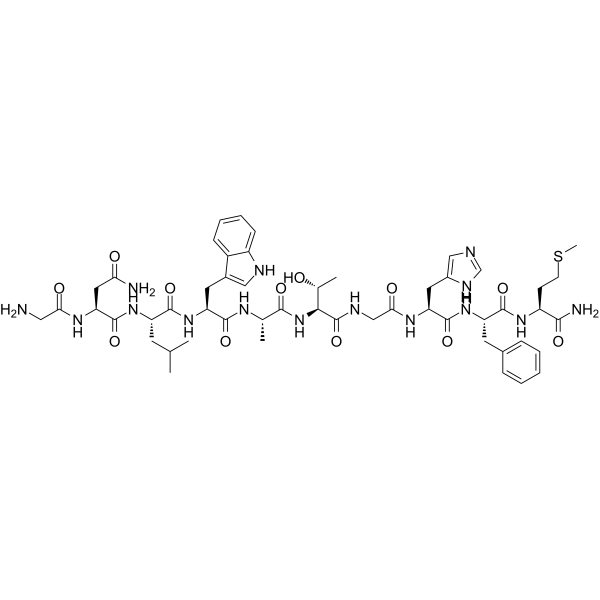
Neuromedin B
CAS No. 87096-84-2
Neuromedin B( —— )
Catalog No. M30141 CAS No. 87096-84-2
Neuromedin B (NMB) is one of the bombesin (BN)-related peptides in mammals. It was originally purified from pig spinal cords, and it has been shown to be present in central nervous system as well as in gastrointestinal tract.
Purity : >98% (HPLC)
 COA
COA
 Datasheet
Datasheet
 HNMR
HNMR
 HPLC
HPLC
 MSDS
MSDS
 Handing Instructions
Handing Instructions
| Size | Price / USD | Stock | Quantity |
| 5MG | 267 | In Stock |


|
| 10MG | 482 | In Stock |


|
| 25MG | 781 | In Stock |


|
| 50MG | 1062 | In Stock |


|
| 100MG | 1431 | In Stock |


|
| 200MG | Get Quote | In Stock |


|
| 500MG | Get Quote | In Stock |


|
Biological Information
-
Product NameNeuromedin B
-
NoteResearch use only, not for human use.
-
Brief DescriptionNeuromedin B (NMB) is one of the bombesin (BN)-related peptides in mammals. It was originally purified from pig spinal cords, and it has been shown to be present in central nervous system as well as in gastrointestinal tract.
-
DescriptionNeuromedin B (NMB) is one of the bombesin (BN)-related peptides in mammals. It was originally purified from pig spinal cords, and it has been shown to be present in central nervous system as well as in gastrointestinal tract.
-
In Vitro——
-
In Vivo——
-
Synonyms——
-
PathwayOthers
-
TargetOther Targets
-
Recptor——
-
Research Area——
-
Indication——
Chemical Information
-
CAS Number87096-84-2
-
Formula Weight1132.29
-
Molecular FormulaC52H73N15O12S
-
Purity>98% (HPLC)
-
SolubilityIn Vitro:?H2O : 12.5 mg/mL (11.04 mM)
-
SMILES——
-
Chemical Name——
Shipping & Storage Information
-
Storage(-20℃)
-
ShippingWith Ice Pack
-
Stability≥ 2 years
Reference
molnova catalog



related products
-
Ortho-Hydroxyphenyla...
ortho-Hydroxyphenylacetic acid (2-hydroxybenzeneacetic acid) can be found in a number of food items such as natal plum lemon verbena half-highbush blueberry and parsley which makes ortho-hydroxyphenylacetic acid a potential biomarker for the consumption of these food products. ortho-Hydroxyphenylacetic acid can be found primarily in blood feces and urine.
-
CPS-11
CPS-11 (N-(Hydroxymethyl)thalidomide) is a Thalidomide analogue with significant antitumor activity, exhibiting a broader and more potent effect on the MM (multiple myeloma) cell line.
-
BIRT-377
BIRT-377 is a negative allosteric LFA-1 modulator.



 Cart
Cart
 sales@molnova.com
sales@molnova.com


